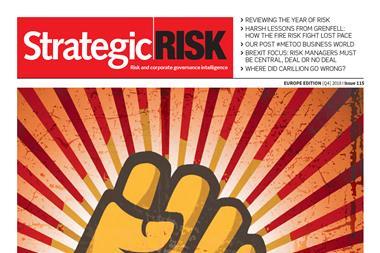Many have rung the death knell for retail over the years, but the sector isn’t dying – it’s just changing. Retail risk managers have their hands full, managing disruptors like AI integration and the next generations’ consumer habits, alongside supply chain issues and loss prevention. Trevor Treharne reports.
Few sectors can claim to have faced as much external pressure and change as the retail sector in recent years.
As if heightened competition and evolving market dynamics were not enough, a global pandemic then exposed a fault line so large that many feared sizable parts of the sector would tumble into the chasm.

Online and social commerce, coupled with advancements in AI and the metaverse, are reshaping retail strategies. At the same time, retailers are grappling with the relevance of bricks and mortar, emerging technologies, and a tricky labour market.
However, the concept of the ‘death of retail’ is often overstated. The Global Powers of Retailing 2023 report from Deloitte showed that the top 250 retail companies posted 8.5% year-on-year growth in revenue, up from 5.2% in the previous year.
This means the challenge for the sector, and its risk managers, is in fact not financial decline and irrelevance but rapid change and disruption.
WHAT RISKS IS RETAIL FACING?
A major issue for retail, within its bricks and mortar stores, is still theft. And while this is not a new challenge, the dynamics are shifting, necessitating innovative solutions from risk management leaders.
Tim Moore, global risk director at New World Norm, and formerly of Peloton, Swarovski, Carphone Warehouse and Homebase, has witnessed first hand the evolution of this issue.
“In an era where the retail sector faces unparalleled challenges, the discourse around loss prevention, team safety and profit protection is at an all-time high,” he says.
“But the retail landscape is undergoing profound transformations. Post-COVID, a noticeable rise in crime has emerged, fuelled by criminals’ increased chances of escaping detection and a diminishing likelihood of facing significant penalties.
“In an era where the retail sector faces unparalleled challenges, the discourse around loss prevention, team safety and profit protection is at an all-time high,”
“Business leaders, weary of the consequences of shoplifting and the growing threat of violence towards retail teams, have collectively declared that enough is enough.”
And this issue is compounded by other disruptions.
Other external pressures range from supply chain disruptions due to geopolitical conflicts to a shifting labour market focusing on work-life balance.
These changes place unprecedented demands on retailers to retain talent and stay competitive.
Eamonn Cunningham, former CRO of Westfield/ Scentre Group, adds: “With the exception of those issues directly coming from the post-COVID environment, many of the challenges faced by the retail sector today were, or should have been, identified some five years ago.
“The risk of AI bias and the potential for statesponsored digital disruptions are genuine concerns that require strategic leadership to mitigate”
“These particular threats, which could also be potential opportunities, include the growth of online sales, technology, generative AI and the impact of Gen Z’s consumer behaviour,” says Cunningham.
Retail marketplaces like Walmart, Amazon and eBay already use generative AI for their customer service offerings. It can also be used to improve search quality, price comparisons, product descriptions and so much more.
Moore echoes the notion that the emergence of AI offers both opportunities and challenges. “The call for a hybrid AI risk management approach is louder than ever, to ensure AI supports, but does not overshadow, human decision-making processes.
“The risk of AI bias and the potential for statesponsored digital disruptions are genuine concerns that require strategic leadership to mitigate,” he says.
SPEND ON RISK CONTROLS
When it comes to mitigating risks, Moore emphasises a strategic approach.
“To navigate these challenges, risk managers must first identify and prioritise the key risks facing their businesses,” he says.
“From violence against staff to supply chain vulnerabilities and the integration of future AI technologies, a comprehensive risk assessment is critical. Collaboration with key stakeholders across the organisation to develop actionable strategies is crucial.
“Have workshops with all parts of the business, discuss what may or may not occur, and attempt to gauge its potential impact”
“Presenting a well-conceived strategic budget plan to invest in risk controls is more pertinent now than ever. It’s a time for proactive engagement and strategic investment in the tools and technologies that will safeguard our future.”
Cunningham says that the answer to managing these risks lies in the fundamentals of risk management.
“Have workshops with all parts of the business, discuss what may or may not occur, and attempt to gauge its potential impact,” he says.
“Given that this is all still relatively new, there is no reliable data to back it up, and as such you have to rely on the experience of people who know the business inside out. It is only when you have a sense of potential impact can you then move to the next stage of planning what to do about what is coming your way.”
LOOKING TO THE FUTURE
Looking ahead, the importance of strategic action, ongoing monitoring, and performance measurement cannot be overstated, Moore believes.
The retail sector must also address the underfunding of security and risk mitigation budgets.
“Outsourcing project work can allow internal teams to focus on strategic planning and execution. In essence, preparing for future risks involves not only anticipating the challenges ahead but also investing in the necessary resources to navigate them effectively,” he says.
For Cunningham, when looking at both current and near-future risks and opportunities, the more impactful ones come from societal change and new technology.
“I am specifically referring to what the Gen Z and the emerging Gen Alpha habits will be as they interact with the retail sector,” he says.
“Preparing for future risks involves not only anticipating the challenges ahead but also investing in the necessary resources to navigate them effectively”
Fully digitally native, Gen Z are adept at navigating online platforms and expect seamless digital experiences. They value transparency and are sceptical of traditional advertising, preferring authentic interactions with brands that align with their values.
“Of course, this is made all the more complicated by another wild card — working from home,” says Cunningham. A remote workforce has had a huge impact on footfall for bricks-and-mortar stores, and has reshaped what we buy as well as where we buy it.
“This aspect is still working itself out as corporates try to encourage a return to the office in some shape or form,” he adds.
The other big future talking point for Cunningham is generative AI. While the area is still relatively young, he anticipates it holding a lot of power.
“You now have a shorter period between initial identification and actual impact on your business”
Its full impact is not yet known, but could begin to reveal itself sooner than we think.
“The key difference from the risk landscape now, as compared with five to 10 years ago, is the fact that average risk velocity has increased,” he says.
“You now have a shorter period between initial identification and actual impact on your business.”
Moore, meanwhile, is acutely aware of the importance of adapting to change, embracing innovation, and prioritising the safety and security of retail environments.
“The journey ahead will be challenging, but with strategic foresight, collaborative problem-solving, and a commitment to innovation, we can navigate the complexities of the modern retail landscape.”














No comments yet